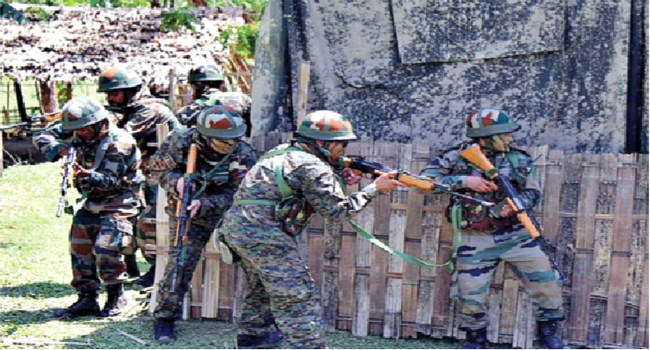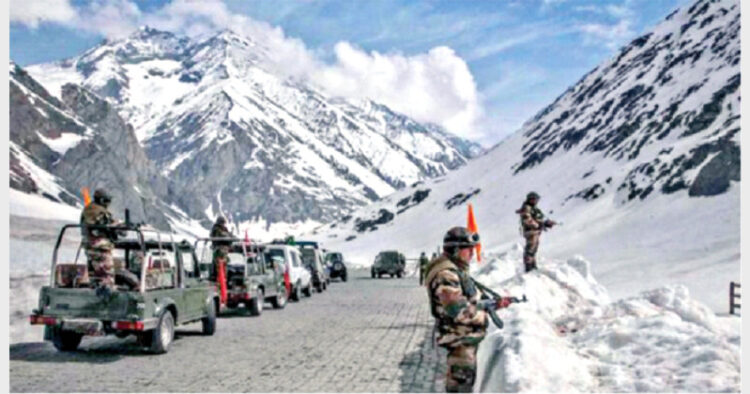The surgical strikes against Pakistan, swift military deployments and taking over Kailash ranges in the post-Galwan Valley clashes represent a substantial shift to an active offensive defense policy. India is not only willing to fight battles on its land and disputed territories, but is also capable to open up new fronts
-Dr Nishtha Kaushiki

Indian troops ready for a face-off with China
The recent deployments of 50,000 soldiers on the Indo-China border have motivated the debate of India adopting an offensive defence doctrine concerning China. Contrary to this assertion, the doctrine in question was already adopted aggressively ever since Prime Minister Narendra Modi took over the country’s reign. Unlike ‘deterrence by denial’, the current offensive posturing of ‘deterrence by punishment’ entails a series of measures in the wake of an evolving battle scenario of a collusive and collaborative Sino-Pak threat looming large on India’s borders.
Although the 2016 and 2019 surgical strikes hinted at India’s offensive doctrine, yet, the strategy was spelled out at the tri-services at the Longewala border in November 2020 by Prime Minister Modi himself when he spoke of retaliation if India’s might was tested. The speech gave out the message of deterrence by punishment which tactically translates into a limited offensive action if provoked. The strategy rules out the first move of confrontation to capture the enemy’s territory. Rather, it focuses on India using its offensive military capabilities if militarily confronted or targeted with terror strikes. The biggest achievement of this strategy has been to punish the aggressor by simultaneously keeping out the nuclear blackmail that India regularly had to face in the past.
Broad Contours of Our Strategy
First, the surgical strikes against Pakistan, swift military deployments, and taking over the Kailash ranges in the post-Galwan Valley clashes represent a substantial shift to an active offensive defense policy. The zeal and enthusiasm of making the adversary understand that India is not only willing to fight battles on its land and disputed territories, but is also capable to open up new fronts acts as a strong deterrence. These signals also convey to the adversaries that India is ready to exploit their existing weakness which eventually has successfully deterred conflicts from spiraling into major ones. Such moves are indicative of India’s strong willpower and resilience of not going to accept compromises concerning the national security objectives. Unlike the previous open hostilities, the developments that were witnessed more recently shifted the onus of maintaining peace and security in the region to both Pakistan and China respectively. Each confrontation was met with an offensive action and posturing that set the ground for high-level and military engagements. Nevertheless, the choice that was picked up by both Pakistan and China differed. India has explicitly made the terms of its cooperation clear which stands parallel to its overall security interests. Unlike previously, India’s behaviour is no longer linked to nuclear blackmail, the mindset of 1962 defeat and its associated helplessness.

India’s surgical strike against Pakistan gave it an upper hand
Today India not only maintains force preponderance on its borders but also has made the mobilisation of troops swifter and more lethal. Also, giving a free hand to the forces to counter the aggression from the other side has not only boosted the morale of the forces but also of the common man who now understands the changing horizons of the battle-space
Can Launch Offensives on New Fronts
Second, the induction of short-range tactical weapons well displays India’s readiness to have interoperability within the forces to initiate limited but small military actions to have the first mover’s advantage. The testing of sophisticated military weaponry such as anti-radiation missile Rudram, Pinaka rocket, and Agni Prime is another chief feature of the nation’s evolving strategy. The use of lightweight, lethal, swift, and most importantly indigenously developed technologies are essential to have precision-targeted strikes without causing harm to the civilian population of the adversary while displaying responsible behavior. Further, the acquisition of weapons systems brought from the allies such as C-17 Globemaster III transport aircraft, C-17 heavy-lifters, Apache attack helicopters, etc. has made mobilisation of the troops in a much swift manner. Imported precision-guided munitions such as Spice 2000 Bombs and Python and Derby air-to-air missiles have also contributed substantially. The cumulative effects have given India an edge to launch offensives on new fronts without warning. In the coming days, the force would be more lethal when co-development and co-production of weapon platforms with allies such as France and Israel would be inducted.
Further, the building of the critical infrastructure along the border has been the thrust of the present government. For example, the recent inauguration of 63 bridges in states primarily neighboring China to give suitable reinforcement to the Army and the Air Force also deters the adversary. Such measures show an intending resolve to act during the time of open hostilities and in peacetime, and by all means, the capability to initiate the first move when the need arises. This is in sharp contrast to the previous policies that discouraged infrastructural development along the border so that ‘peace and tranquility’ could be maintained. Previously, the fear of the adversary’s perceptions of taking development as an offensive preparation also hindered the overall growth of the North-Eastern region as well as Kashmir. Times have thus changed. Today India not only maintains force preponderance on its borders but also has made the mobilisation of troops swifter and more lethal. Also, giving a free hand to the forces to counter the aggression from the other side has not only boosted the morale of the forces but also of the common man who now understands the changing horizons of the battle-space.
Third, the upcoming commissioning of unified theatre commands is another indication of a ‘New India’ that aims to use the factor of interoperability between various platforms and forces. In simple terms, a unified command is a common platform in which the Army, Air Force, and the Navy combine their resources and undertake joint operations against an existing or a potential threat. Recommended after the Kargil War, it was only after the appointment of General Bipin Rawat as CDS in January 2020 that significant developments have been made towards a unified command. As per the reports, most probably by the upcoming Independence Day or later this year, India will make several important announcements concerning this. Apart from the flexibility and the swiftness in future military operations, the elements of surprise and deception that will be employed would be game-changers on the battlefield.
Finally, apart from the military aspect, there is an intertwined diplomatic dimension too of the strategy. Exploiting the internal contradictions of the adversary by aiming for its international isolation through sustained efforts is what the strategy aims for. As a part of the strategy, India under the efforts of PM Modi has aggressively tried to isolate both Pakistan and China by sensitising the international community of their misdeeds. Diplomatic isolation over time can lead to delegitimizing the government that can have both short-term and long-term consequences. Pakistan’s isolation on the grounds of terror, especially in FATF and China’s possible strategic encirclement by G7 and India on the grounds of the origin of the Covid Virus leaves little choices for them. As international isolation will get stronger, future economic agreements might be jeopardized. This might lead to an economic stagnancy which will affect its OBOR initiatives. This will help in restraining its aggressive posturing towards its neighbors.
At the end, one can confidently put across the view that both in terms of doctrine as well as capabilities, the current regime has facilitated positive substantial changes. The current strategy has given more space to liberally accommodate more actions while dealing with the adversaries. As of now, India’s military, tactical and strategic position has thwarted the contemporary threats, but, the rapidly changing battlefront and the shifting sands of the strategic alignments may further compel India to bring out changes, most probably in its nuclear doctrine. What happens next is better to be left to the developments and the master strategist- Ajit Doval.
(The writer is working in Central University of Punjab (Bathinda) as an Assistant Professor in the Department of South and Central Asian Studies. Her research areas are security and defence studies)













Comments